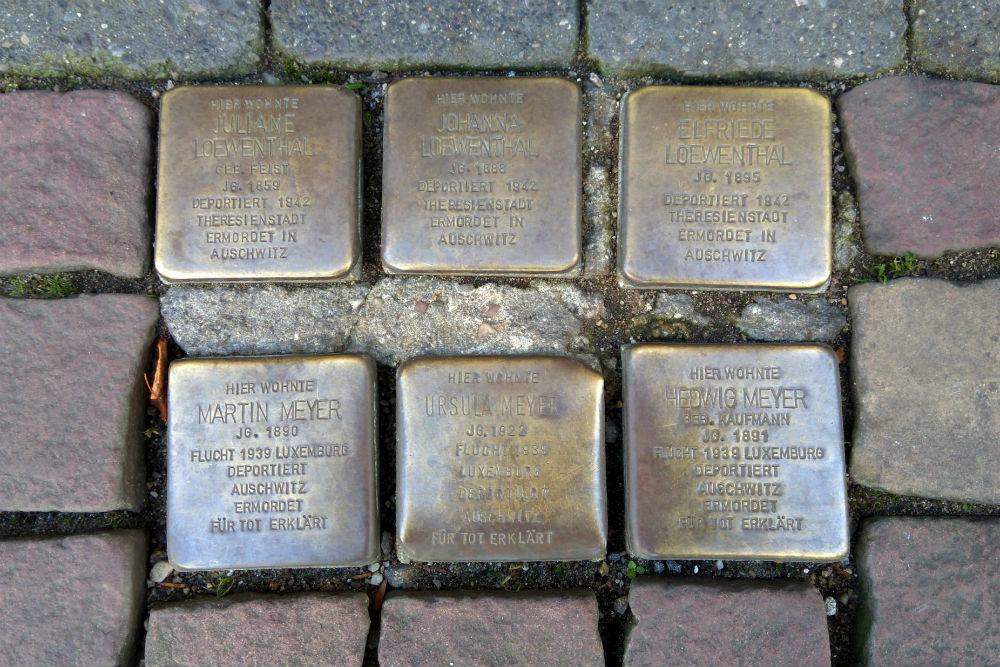Stumbling Stones Bahnstraße 44
These Stolpersteine (stumbling stones) commemorate:
* Juliane Loewenthal née Feist, born 1859, deported 1942 to Theresienstadt, murdered in Auschwitz.
* Johanna Loewenthal, born 1888, deported 1942 to Theresienstadt, murdered in Auschwitz.
* Elfriede Loewenthal, born 1895, deported 1942 to Theresienstadt, murdered in Auschwitz.
* Martin Meyer, born 1890, fled to Luxemburg 1939, deported to Auschwitz, murdered, declared dead.
* Hedwig Meyer, born 1922, fled to Luxemburg 1939, deported to Auschwitz, murdered, declared dead.
* Ursula Meyer née Kaufmann, born 1891, fled to Luxemburg 1939, deported to Auschwitz, murdered, declared dead.
Juliane Loewenthal and her husband Moses had 3 daughters – Johanna, Elfriede (a teacher) and Henriette. Moses died in 1930.
One source gives some information that isn’t consistent with the stolpersteine. It states that Johanna was deported in April 1942 to Izbica and from there to the Sobibor death camp. Juliane and daughter Elfriede were deported in July 1942 via Düsseldorf to Theresienstadt in July 1942. Julianne died there 6 months later, age 84. Elfriede was probably deported onward to Auschwitz; on 31 December 1945 she was declared dead. No information is known about what happened to Henriette.
Martin Meyer and Ursula Kaufmann were married in 1920 and two years later had a daughter, Hedwig. Martin was a banker. Hedwig attended school. In 1939, the family fled to Luxemburg but did not escape. They were deported via Theresienstadt to Auschwitz in 1942, with details of their deportations and deaths unknown. After the end of the war, on 31 December 1945, all three were officially declared dead.
"Stolpersteine" is an art project for Europe by Gunter Demnig to commemorate victims of National Socialism (Nazism). Stolpersteine (stumbling stones) are small, 10x10cm brass plaques placed in the pavement in front of the last voluntary residence of (mostly Jewish) victims who were murdered by the Nazis. Each plaque is engraved with the victim’s name, date of birth and place (mostly a concentration camp) and date of death. By doing this, Gunter Demnig gives an individual memorial to each victim. One stone, one name, one person. He cites the Talmud: "A human being is forgotten only when his or her name is forgotten."
For more information and pictures, please visit Stolpersteine Mülheim an der Ruhr (in German).
Do you have more information about this location? Inform us!
Source
- Text: Fedor de Vries & Anne Palmer
- Photos: wie-wolf
- Projekt Stolpersteine in Mülheim an der Ruhr
- Stolpersteine.eu
Nearby
Museum
Point of interest
Monument
- War Memorial Mülheim an der Ruhr - Mülheim an der Ruhr
- War Memorial Wasserrinne - Mülheim an der Ruhr
- Bismarck-tower Mülheim an der Ruhr - Mülheim an der Ruhr
Cemetery
- German War Cemetery Uhlenhorst - Mülheim an der Ruhr
- Kaiserberg German War Cemetery - Duisburg
- German War Graves Essen-Fulerum - Essen-Fulerum





